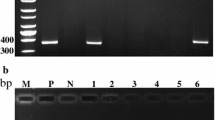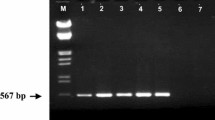Abstract
Shoot apices ofCarica papaya were multiplied in vitro on solidified nutrient media supplemented with α-naphthyl-acetic acid and 6-benzylaminopurine. The micropropagated shoots were inoculated in vitro, through a stem wound, with a sporangial suspension (1.2×104 sporangia ml-1) ofPhytophthora palmivora. The symptoms exhibited by the shoots in vitro were similar to those described previously for infection of the whole plant in the field. The time taken for the host tissue to become brown and to wilt and the time to sporulation of the pathogen were all recorded for each shoot of four varieties of papaya challenged with each of ten isolates ofP. palmivora. Significant differences were observed between host-pathogen combinations for these variables and host-specificity was detected amongst the isolates ofP. palmivora. The time taken for the shoot to wilt was positively correlated with the time to sporulation of the isolated but both these variables were negatively correlated with the time to browning of the shoot. In vitro selection for disease resistance will be useful during breeding programmes involving papaya genotypes which are maintained through clonal propagation.
Similar content being viewed by others
References
Daub, ME (1986) Tissue culture and the selection of resistance to pathogens. Ann Rev Phytopathol 24: 159–186
Scowcroft, WR, Larkin, PJ, Brettell, RIS (1983) Genetic variation from tissue culture. In: Helgeson, JP, Deverall, BJ (Eds) Use of Tissue Culture and Protoplasts in Plant Pathology, pp 139–162. Academic Press, Sydney
Diner, AM, Mott, RL (1985) In vitro inoculation of western white pine tissue culture propagules with vegetative hyphae ofCronartium ribicola. Phytopathology 75: 1130–1131
Gray, DJ, Amerson, HV (1985) In vitro colonisation and resistance of loblolly pine embryos infected with the fusiform rust fungus. In: Henke, RR, Hughes, KW, Constantin, MJ, Hollaender, A (Eds) Tissue Culture in Agriculture and Forestry, pp 257–270. Plenum Press, New York
Ingram, DS, MacDonald, MV (1986) In vitro selection of mutants. In: Nuclear Techniques and In vitro Culture for Plant Improvement, pp 241–258. International Atomic Energy Agency, Vienna
Ribeiro, OK (1978) A Source Book of the GenusPhytophthora. AR Gantner Verlag K-G, Vaduz
Gregory, PH (1983) Some major epidemics caused byPhytophthora. In: Erwin, DC, Bartnicki-Garcia, S, Tsao, PH (Eds)Phytophthora: Its Biology, Taxonomy, Ecology and Pathology, pp 271–278. American Phytopathological Society, St Paul
Alvarez, AM, Nelson, MG (1982) Control ofPhytophthora palmivora in papaya orchards with weekly sprays of chlorothalonil. Plant Disease 66: 37–39
Murashige, T, Skoog, F (1962) A revised medium for rapid growth and bioassays with tobacco tissue cultures. Physiol Plant 15: 473–497
Anon (1977) GENSTAT, A General Statistical Program. Lawes Agricultural Trust, Rothamsted Experimental Station
Litz, RE, Conover, RA (1978) In vitro propagation of papaya. HortScience 13: 241–242
Parris, GK (1942)Phytophthora parasitica on papaya (Carica papaya) in Hawaii. Phytopathology 32: 314–320
Keen, NT, Wang, MC, Bartnicki-Garcia, S, Zentmeyer, GA (1975) Phytotoxicity of mycolaminarans-β-1,3-glucans fromPhytophthora spp Physiol Plant Pathol 7: 91–97
Person, C (1966) Genetic polymorphism in parasitic systems. Nature 212: 266–267
Ko, WH (1971) Biological control of seedling root rot of papaya caused byPhytophthora palmivora. Phytopathology 61: 780–782
Helgeson, JP (1983) Studies of host-pathogen interactions in vitro. In: Helgeson, JP, Deverall, BJ (Eds) Use of Tissue Culture and Protoplasts in Plant Pathology, pp 9–38. Academic Press, Sydney
Litz, RE (1986) Papaya (Carica papaya L.) In: Bajaj, YPS (Ed) Biotechnology in Agriculture and Forestry. Vol 1, Trees, pp 220–232. Springer-Verlag, Berlin
Weste, G (1983) Population dynamics and survival ofPhytophthora. In: Erwin, DC, Bartnicki-Garcia, S, Tsao, PH (Eds)Phytophthora: Its Biology, Taxonomy, Ecology and Pathology, pp 237–251. American Phytopathological Society, St Paul
Utkhede, RS (1986) In vitro screening of the world apple germplasm collection for resistance toPhytophthora cactorum crown rot. Scientia Hortic 29: 205–210
Samson, JA (1980) Tropical Fruits. Longman, London
Author information
Authors and Affiliations
Rights and permissions
About this article
Cite this article
Sharma, N.K., Skidmore, D.I. In vitro expression of partial resistance toPhytophthora palmivora by shoot cultures of papaya. Plant Cell Tiss Organ Cult 14, 187–196 (1988). https://doi.org/10.1007/BF00043409
Received:
Accepted:
Issue Date:
DOI: https://doi.org/10.1007/BF00043409




